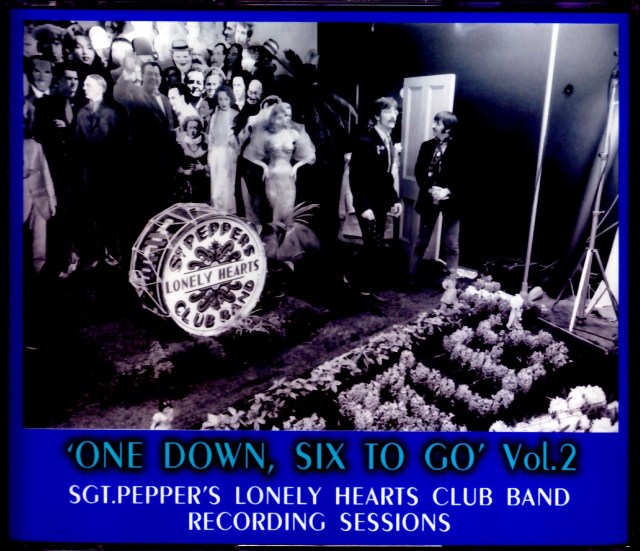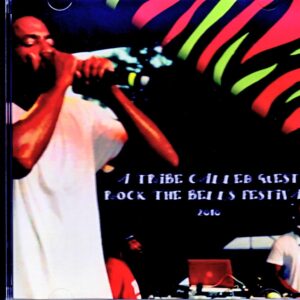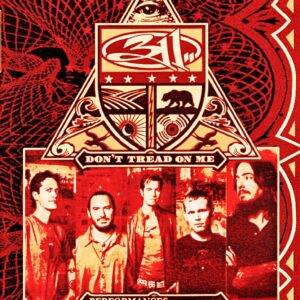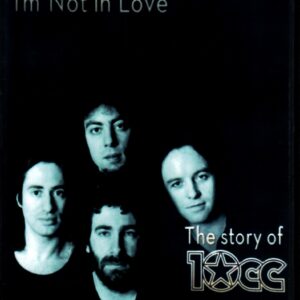Description
Sgt. Pepper’s was released in June 1967. There were already signs of the hippie movement blooming in various fields, but it was none other than The Beatles’ Sgt. Pepper’s that marked the beginning of psychedelic social phenomenon. Not only was it the beginning, but it is still recognized as a masterpiece today, half a century after its release, as a symbol of the era. Perhaps under the influence of drugs, the lyrics are full of metaphors, and the melody is brilliant and fantastical. All of these elements give the impression of a new musicality of The Beatles that was different from what they had done before. The result of giving up all live performances and concentrating on studio work was this concept album that brought together the best of the studio technology of the time. The concept of the album is that a fictional band led by Sergeant Pepper performs a show, starting with the hustle and bustle of the crowd, followed by entertainers appearing one after another, a reluctant ending, and a solemn encore. However, not all songs are necessarily recorded according to this concept, as can be seen by listening to “Lovely Rita”, “When I’m Sixty Four”, “Within You Without You”, etc. Roughly speaking, only the first few songs and the reprise and after are in line with the concept, and the songs in between are unrelated. If there is something that resembles a concept, it would be the melody that permeates the whole album, and the tone that has undergone complex work. This atmosphere can be felt as a lingering scent in the next album, Magical. If I had to say, the concept of this album is a symbol that embodied the psychedelic worldview and established it in the era. The album was released in June 1967, but recording began around December 1966. The last tour was in August, so the recording took place after a three-month break. Considering that “Revolver” was recorded from April to June, we can see how much creative motivation there was during this period, including the tour. This work is the title of the recording session for the album “Sgt. Pepper’s”. [Being for the Benefit of Mr. Kite] John wrote this song inspired by a circus poster, and it is a theme that coincides with the concept of the album. For Westerners, the circus is like a symbol of the extraordinary, suddenly appearing in the endless daily life and disappearing before you know it. This is a masterpiece that embodies the atmosphere of that other world with John’s unique worldview. At first, they take multiple takes, but John makes frequent mistakes and keeps interrupting. Paul is also recorded giving his opinion in the studio. John’s singing, who is a separate vocalist, is powerful and wonderful, over the still unfinished backing, and this is the charm of live singing. The backing is simple, with only the sound of a hand-operated organ and drums, but the world of that song is already complete, and all that is added is “chaos” from the very beginning. There are many interesting takes, such as John singing “la la la” in the interlude. And since John re-sings the vocals for each take, it is also interesting to listen to the fact that all the vocals are different. Tracks 10 and 11 on Disc 1 are circus-like sound effects. It is surprising that such things even exist. [WITHIN YOU WITHOUT YOU] This is probably George’s Indian music, which is considered unnecessary on the album. It was recorded from the recording rehearsal that took place on March 15, 1967. It shows George practicing with a demo song for an Indian band. It is unclear whether George’s demo song is lyrics or a mantra, and it is a song that is far different from the released version. Although the instruments are Indian instruments, the recording method is the same as before, with the sitar and violin layered to complete the song. Track 30 on Disc 1 is probably the highlight of the album. It is a single vocal with no effects applied to George’s vocals. He sings as if he is having a very polite conversation. [WHEN I’M SIXTY FOUR] This is a heartwarming song that depicts the happy old age that young Paul will have in the future when he is old. Paul is already over this age now, but there was no special performance at the age of 64, and it was only performed once at a private party on Ringo’s 64th birthday. In the recording that took place from December 6, 1966, comments for the fan club’s Christmas record were recorded before starting the song. Starting with track 6 on disc 2, the tempo seems somewhat slow and Paul’s vocals seem to be drawn out, but in fact this is the correct pitch, and the released version was recorded with the pitch intentionally raised. Paul’s vocals are a different take, and it is clear that he is enjoying singing, adding interjections here and there even outside of the singing. Take 3 does not include a chorus, but an overdub session was held on December 20th, and it is almost complete. Track 8 is a track with a low-pitched clarinet, which is characteristic of this song. [LOVELY RITA] This song was created because the female police officer who handled the case when Paul was asked about a parking violation was named Rita. At the recording on February 23rd, 1967, it was still just a rehearsal, and the performance was rough from start to finish. It is interesting that John is enthusiastic, saying “Let’s do it,” even though it is Paul’s song. The intro “Aaaah” is not yet there, and in track 16, you can hear Paul intentionally singing in a youthful, high-pitched voice. Paul’s greatness as a vocalist can be felt in the way he uses various vocal tones depending on the song, and yet makes it convincing that they are all Paul’s voice. It is a single vocal, and the singing is like a trial and error, and you can hear ad-lib vocals at the end of the song. In track 17, effects are added to the vocals, making it closer to the released version. Take 11, recorded on March 7, 1967, is the first to include the “aaaahhhh” at the beginning, although it is still modest. Track 19 is the entire vocal track, including the chorus. Track 20 is a piano interlude by George Martin. [GOOD MORNING GOOD MORNING] The first recording is a demo by John alone. It is a very early version of the song. Recording began on February 8, 1967. Take 1 has an arrangement that is like an intense hard rock. The final version retains that atmosphere, but it is a song that only John, with his impressive guitar riff, could have made. Track 33 on disc 2 is a version with a raw single vocal. It is wonderful to hear John singing the lyrics quickly and without even stumbling. Track 35 is a take with a brass section layered on top to create a noisy sound. Track 4 on disc 4 is the animal effect sound used effectively in the song. As is well known, the sounds are arranged in the order of the plant chain. Here, it is recorded for over a minute and a half, which is longer than the conventional version. And track 5 is a surprising unedited version without fade-out. In the release version, the animal sounds overlap with the fade-out, but here Paul and John’s ad-lib vocals continue endlessly, and even the exchange between the two, like “Hey Bulldog”, is recorded completely. [SGT.PEPPER’S REPRISE] This is a reprise of the title song. Take 1 feels more like a rehearsal sound than a song, but the phrases heard everywhere, and the high-pitched beep sound in the intro, are not wasted but are firmly utilized in the song. Track 12 is interesting because Paul sings quite carelessly. Track 13 is even more careless, and it feels more like talking than singing. Track 17 is a chorus part clearly by John’s voice. Track 18 is a sound effect of applause and cheers. The crowd effects heard in the intro to the title track can also be heard, so they were probably recorded on the same tape in the library. Before “Sgt. Pepper’s” became “Sgt. Pepper’s”, the members had the working title “One Down, Six to Go”. This work is titled after that. It is a big project that includes many first-time recordings, and it covers the entirety of the album, taking up the equivalent of 10 discs. This work is the sequel. It includes studio session recordings from the recording of “Mister Kite”, which is the deepest part of the album, to “A Day in the Life”, and “Only a Northern Song” from the same period. This is the ultimate set that includes many first-time recordings that have never been recorded anywhere before. It is longer than previously released, and includes some that are recorded unedited for the first time. DISC ONE BEING FOR THE BENEFIT OF MR KITE February 17, 1967 01. Take 1 (breakdown) 02. Take 2 (breakdown) 03. Take 3 (breakdown) 04. Studio Chat 05. Take 4 06. Take 7 07. Mixdown of Take 7 08. Take 8 09. Take 9 Vocal SI w/ADT February 20, 1967 10. Effects Tape process 11. Final Effects Tape March 28, 1967 Overdubs 12. Organ & Guitar solo SI 13. Bass Harmonica & Organ #2 SI March 29, 1967 Overdubs 14. Tape Effects SI #1 15. Tape Effects SI #2 16. Tape Effects SI #3 17. Organ SI 18. Tape Effects SI #4 March 31, 1967 Overdubs 19. Uknown Mono Remix MULTITRACK 20. Drums 21. Bass 22. Instrumental WITHIN YOU WITHOUT YOU March 15, 1967 23. Rehearsal #1 24. Rehearsal #2 25. Take 1 March 22, 1967 Overdubs 26. Take 2 Dilruba SI April 3, 1967 ubs 27. Violins and Cellos SI 28. Sitar SI 29. Remix of Take 2 30. Pure Vocal track SI 31. ADT Vocal effect MULTITRACK 32. Control Room 33. Dilruba & Swardmandala 34. Tabla & Tamboura DISC TWO WHEN I’M SIXTY FOUR December 6, 1966 01. Messages For Radio London 02. Messages For Radio Caroline 03. Take 1 (partial) 04. Take 2 05. Piano recording December 8, 1966 06. Vocal SI on Take 2 December 20, 1966 overdubs 07. Take 3 December 21, 1966 overdubs 08. Clarinets SI on Take 4 MULTITRACK 09. Bass and Drums 10. Vocals 11. Backing vocals & Bell 12. Backing Track Mix LOVELY RITA February 23, 1967 13. Take 1 (partial) 14. Take 8 15. Take 9 Bass SI February 24, 1967 16. Take 9 vocal SI 17. Vocal SI #2 March 7, 1967 18. SI on Take 11 19. All vocal tracks March 21, 1967 20 GM Piano SI MULTITRACK 21. Drums 22. Bass 23. Acoustic Guitars 24. Pianos & Combs 25. Instrumental GOOD MORNING GOOD MORNING 26. Corn Flakes Commercial 1967 Jan-Feb, 1967 Home Recording 27. Demo #1 (breakdown) 28. Demo #2 February 8, 1967 29. Take 1 30. Take 2 (partial) 31 . Take 8 February 16, 1967 32. Bass SI 33. Take 8 Vocal SI 34. Take 9 ADT Vocal March 13, 1967 35. Brass SI onto Take 10 DISC THREE GOOD MORNING GOOD MORNING March 28, 1967 01. Guitar Solo SI 02 . Take 11 Vocal SI 03. Take 11 Backing Vocals SI March 29, 1967 04. Sound Effects RM20 05. Unedited Take 11 MULTITRACK 06. Drums 07. Guitars 08. GM Mixing Desk 09. Instrumental SGT PEPPER (REPRISE) April 1, 1967 10. Take 1 (partial) 11. Take 2 (breakdown) 12. Take 5 w/Bass SI 13. Take 8 (unedited) 14. Take 9 (unedited) Overdubs 15. Bass SI 16. Final Track 17. Vocals 18. Sound Effects 19. Remix 9 MULTITRACK 20. Instrumental EXTRA 21. Edited 8 Track Version A DAY IN THE LIFE January 19, 1967 22. Take 1 (unedited) 23. Take 2 24. Take 3 (intro only) 25. Take 4 (partial w/voiceover) 26. New Vocal onto Take 4 27. Take 4 SI 28. Piano SI #1 29. Piano SI #2 January 20, 1967 30. Reduction Take 6 31. Take 6 Drums, Bass & Vocal SI January 30, 1967 32. RM1 from Take 6 February 3, 1967 Overdubs 33. New Piano & Maracas 34. Pianos & Maracas SI(4 track tape) 35. New Bass & Drums SI (4 track tape)






Reviews
There are no reviews yet.